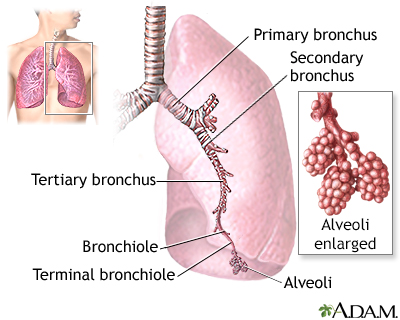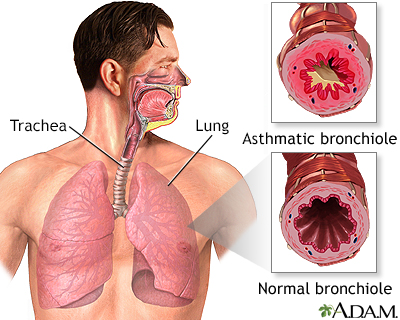Wheezing
Sibilant rhonchi; Wheezing asthma; Wheezing - bronchiectasis; Wheezing - bronchiolitis; Wheezing - bronchitis; Wheezing - COPD; Wheezing - heart failure
Wheezing is a high-pitched whistling sound during breathing. It occurs when air moves through narrowed breathing tubes in the lungs.

The major features of the lungs include the bronchi, the bronchioles and the alveoli. The alveoli are the microscopic blood vessel-lined sacks in which oxygen and carbon dioxide gas are exchanged.

Asthma is a disease in which inflammation of the airways causes airflow into and out of the lungs to be restricted. When an asthma attack occurs, mucus production is increased, muscles of the bronchial tree become tight, and the lining of the air passages swells, reducing airflow and producing the characteristic wheezing sound.
Considerations
Wheezing is a sign that a person may be having breathing problems. The sound of wheezing is most apparent when breathing out (exhaling). It may also be heard when breathing in (inhaling).
Wheezing most often comes from the small breathing tubes (bronchial tubes) deep in the lungs. But it may be due to a blockage in larger airways or in people with certain vocal cord problems.
Causes
Causes of wheezing may include any of the following:
- Asthma
- Breathing a foreign object into the airways to the lungs
- Damage and widening of the large airways in the lungs (bronchiectasis)
- Swelling and mucus buildup in the smallest air passages in the lungs (bronchiolitis)
- Swelling and mucus buildup in the main passages that carry air to the lungs (bronchitis)
- Chronic obstructive pulmonary disease (COPD), especially when a respiratory infection is present
- Acid reflux disease
- Heart failure (cardiac asthma)
- Insect sting that causes an allergic reaction
- Certain medicines (such as aspirin)
- Infection of the lungs (pneumonia)
- Smoking
- Viral infection, especially in infants younger than age 2
Home Care
Take all of your medicines as directed.
Sitting in an area where there is moist, heated air may help relieve some symptoms. This can be done by running a hot shower or using a vaporizer.
When to Contact a Medical Professional
Contact your health care provider if wheezing:
- Occurs for the first time
- Occurs with significant shortness of breath, bluish skin, confusion, or mental status changes
- Keeps occurring without explanation
- Is caused by an allergic reaction to a bite or medicine
If wheezing is severe or occurs with severe shortness of breath, you should go directly to the nearest emergency department.
What to Expect at Your Office Visit
Your provider will perform a physical exam and ask about your medical history and symptoms. Questions about your wheezing may include when it started, how long it has lasted, when it is worse, and what might have caused it.
The physical exam may include listening to the lung sounds (auscultation). If your child has the symptoms, their provider will make sure your child didn't swallow a foreign object.
Tests that may be done include:
- Blood tests, possibly including arterial blood gases
- Chest x-ray
- Lung function tests
- Pulse oximetry to measure blood oxygen level
A hospital stay may be needed if:
- Breathing is particularly difficult
- Medicines need to be given through a vein (IV)
- Supplemental oxygen is required
- The person needs to be closely watched by medical personnel
References
Doss AMA, Stokes JR. Viral infections and wheezing in preschool children. Immunol Allergy Clin North Am. 2022;42(4):727-741. PMID: 36265972
Kliegman RM, St. Geme JW, Blum NJ, et al. Wheezing, bronchiolitis, and bronchitis. In: Kliegman RM, St. Geme JW, Blum NJ, et al, eds. Nelson Textbook of Pediatrics. 22nd ed. Philadelphia, PA: Elsevier; 2025:chap 439.
Woodruff PG, Bhakta NR, Ortega VE, Lambrecht BN, Fahy JV. Asthma: pathogenesis and phenotypes. In: Broaddus VC, Ernst JD, King TE, et al, eds. Murray and Nadel's Textbook of Respiratory Medicine. 7th ed. Philadelphia, PA: Elsevier; 2022:chap 60.
Version Info
Last reviewed on: 4/1/2024
Reviewed by: Charles I. Schwartz, MD, FAAP, Clinical Assistant Professor of Pediatrics, Perelman School of Medicine at the University of Pennsylvania, General Pediatrician at PennCare for Kids, Phoenixville, PA. Also reviewed by David C. Dugdale, MD, Medical Director, Brenda Conaway, Editorial Director, and the A.D.A.M. Editorial team.
